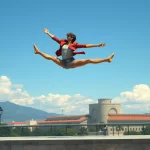Sissonne: The Scissor-Like Jump

Introduction
Ballet is a classical dance form that demands precision, grace, and strength. Among the myriad of movements that make up this beautiful art form, the Sissonne stands out for its elegance and complexity. Named after the French nobleman who is believed to have invented it, the Sissonne is a scissor-like jump that requires both technical skill and artistic expression.
The importance of the Sissonne in ballet cannot be overstated. It is a fundamental jump that showcases a dancer’s ability to combine power with finesse. Whether performed in a solo variation or as part of a corps de ballet, the Sissonne adds a dynamic element to any performance.
In this article, you will learn about the historical background of the Sissonne, a technical breakdown of how to perform it, key elements of technique, common mistakes and how to avoid them, its applications in choreography, and training exercises to master this intricate movement. Additionally, we will address frequently asked questions to provide a comprehensive understanding of the Sissonne.
Historical Background
The origins of the Sissonne can be traced back to the early days of ballet in the 17th century. It is named after the Comte de Sissonne, a French nobleman who is credited with its invention. The movement quickly gained popularity and became a staple in the repertoire of classical ballet.
Over time, the Sissonne has evolved, with various choreographers and dancers adding their unique interpretations. Notable figures such as Marius Petipa and George Balanchine have incorporated the Sissonne into their choreographies, further cementing its place in ballet history. Dancers like Rudolf Nureyev and Margot Fonteyn have also been celebrated for their exceptional execution of this jump.
Technical Breakdown
Performing a Sissonne requires a combination of strength, coordination, and timing. Here is a step-by-step explanation of how to execute this movement:
- Preparation: Begin in a plié position, with your knees bent and feet turned out. This will provide the necessary spring for the jump.
- Takeoff: Push off the floor with both feet, extending your legs and pointing your toes. Your body should rise into the air in a scissor-like motion.
- Split: At the peak of your jump, split your legs apart, with one leg extending forward and the other backward. Ensure that both legs are fully extended and toes are pointed.
- Descent: As you begin to descend, bring your legs back together and prepare to land.
- Landing: Land softly on one foot, with the other foot in a coupé position (toes touching the ankle of the supporting leg). Immediately transition into a plié to absorb the impact.
Key positions and transitions include the initial plié, the scissor-like split in the air, and the controlled landing. Common variations of the Sissonne include the Sissonne Ouverte (open) and Sissonne Fermée (closed), which differ in the position of the legs during the landing.
Key Elements of Technique
Balance
Maintaining balance during a Sissonne is crucial. Focus on engaging your core muscles and keeping your weight centered. Practice balancing exercises, such as standing on one leg, to improve your stability.
Posture
Proper body alignment and positioning are essential for executing a Sissonne with grace. Keep your back straight, shoulders down, and head held high. Ensure that your legs are fully extended and toes are pointed during the jump.
Timing
Understanding the rhythm and timing of a Sissonne is key to its successful execution. Practice with a metronome or to music to develop a sense of timing. Pay attention to the timing of your takeoff, split, and landing.
Strength and Flexibility
The muscles involved in a Sissonne include the quadriceps, hamstrings, calves, and core. Strengthen these muscles through targeted exercises such as squats, lunges, and core workouts. Flexibility is also important, particularly in the hip flexors and hamstrings. Incorporate stretching routines into your training to improve your range of motion.
Common Mistakes and How to Avoid Them
Here are some frequent errors dancers make when performing a Sissonne, along with tips and corrections to prevent these mistakes:
- Insufficient Height: Ensure you push off the floor with enough force to achieve the necessary height. Strengthen your leg muscles and practice jumps to improve your elevation.
- Improper Split: Make sure your legs are fully extended and toes are pointed during the split. Practice splits on the ground to improve your flexibility and muscle memory.
- Uncontrolled Landing: Focus on landing softly and in a controlled manner. Engage your core and use your plié to absorb the impact. Practice landing drills to improve your control.
- Poor Timing: Work on your timing by practicing with a metronome or to music. Break down the movement into smaller parts and focus on the timing of each element.
Applications in Choreography
The Sissonne is featured prominently in many famous ballets and routines. For example, it is often seen in the grand pas de deux of classical ballets such as “Swan Lake” and “The Nutcracker.” In contemporary ballet, choreographers like George Balanchine have used the Sissonne to add dynamic flair to their pieces.
This movement is versatile and can be adapted to different ballet styles. In classical ballet, it is performed with a focus on precision and grace. In contemporary ballet, it may be executed with more freedom and expression. Regardless of the style, the Sissonne adds a dramatic and visually striking element to any choreography.
Training Exercises
To master the Sissonne, incorporate the following exercises and drills into your training routine:
- Pliés: Practice pliés to build strength and flexibility in your legs. Focus on maintaining proper alignment and engaging your core.
- Jumps: Perform various jumps, such as sautés and jetés, to improve your elevation and control. Pay attention to your takeoff and landing technique.
- Splits: Practice splits on the ground to improve your flexibility. Hold each split for at least 30 seconds to increase your range of motion.
- Core Workouts: Strengthen your core with exercises such as planks, sit-ups, and leg raises. A strong core is essential for maintaining balance and control during a Sissonne.
Conditioning routines that support the required strength and flexibility include yoga, Pilates, and resistance training. These activities will help you develop the necessary physical attributes to perform a Sissonne with ease and grace.
FAQ
How long does it take to master a Sissonne?
The time it takes to master a Sissonne varies depending on the dancer’s experience, physical condition, and dedication to practice. On average, it may take several months of consistent training to achieve proficiency.
What are the most important muscles to strengthen for a Sissonne?
The most important muscles to strengthen for a Sissonne are the quadriceps, hamstrings, calves, and core. These muscles provide the power and stability needed for the jump.
Can beginners attempt a Sissonne?
While the Sissonne is an advanced movement, beginners can attempt it with proper guidance and training. Start with basic jumps and gradually progress to more complex movements as your strength and technique improve.
What are some common injuries associated with a Sissonne?
Common injuries associated with a Sissonne include ankle sprains, knee injuries, and muscle strains. To prevent these injuries, ensure proper warm-up, use correct technique, and listen to your body to avoid overexertion.
How can I improve my technique for a Sissonne?
To improve your technique for a Sissonne, focus on strengthening your leg and core muscles, improving your flexibility, and practicing the movement regularly. Seek feedback from instructors and use video analysis to identify areas for improvement.
Conclusion
In conclusion, the Sissonne is a captivating and technically demanding ballet movement that requires strength, balance, and precision. By understanding its historical background, mastering the technical elements, and incorporating targeted training exercises, dancers can achieve proficiency in this elegant jump. Remember to practice consistently, seek feedback, and enjoy the journey of refining your Sissonne.





